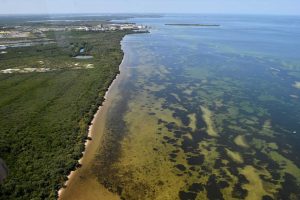Piney Point wastewater may fuel harmful algae bloom along Florida coast, experts say

FORT MYERS, Fla. – Environmental groups worry recent releases from the Piney Point wastewater treatment facility near Tampa Bay will eventually fuel an algae bloom that could impact areas of coastal Florida.
Nutrient-rich waters from the treatment facility will offset natural balances in the coastal estuaries and will eventually end up in the Gulf of Mexico, where red tide initiates.
“It does seem like if they pump that volume of water into Tampa Bay that it could very likely stimulate an algae bloom,” said John Cassani of the southwest Florida non-profit organization Calusa Waterkeeper. “But they’re not telling us the concentrations of nitrogen and phosphorus. Usually you look at concentrations, and they’re not giving us that data.”
A harmful algal bloom, also known as red tide, occurs when algae grow out of control and yield toxic or harmful effects on people and wildlife, according to the National Oceanic and Atmospheric Administration.
Karenia brevis is the naturally occurring organism that causes red tide blooms. But the organism can grow to toxic concentrations when conditions are right and spread from the Tampa area south to the Florida Keys.
The latest on Piney Point: Millions of gallons of wastewater being pumped into Tampa Bay; Florida reservoir breach is ‘not getting worse,’ officials say
The region was partially crippled during a 17-month red tide bloom that started in the fall of 2017 and lasted until the spring of 2019.
Red tide blooms have occurred throughout Florida’s history, but researchers from the University of Miami say they are stronger, more frequent and longer lasting than they were 50 years ago.
Millions of gallons of wastewater were pumped out of holding facilities at Piney Point in hopes of cutting down on the likelihood of a larger breach.
“It has heavy metals and all kinds of problems,” said Jacki Lopez with the Center for Biological Diversity. “(The Florida Department of Environmental Protection) should be looking for fish kills and algae blooms. You have a high volume of nutrients coming down in a short period of time, and that’s going to affect the marine ecosystem.”
Source: Read Full Article
